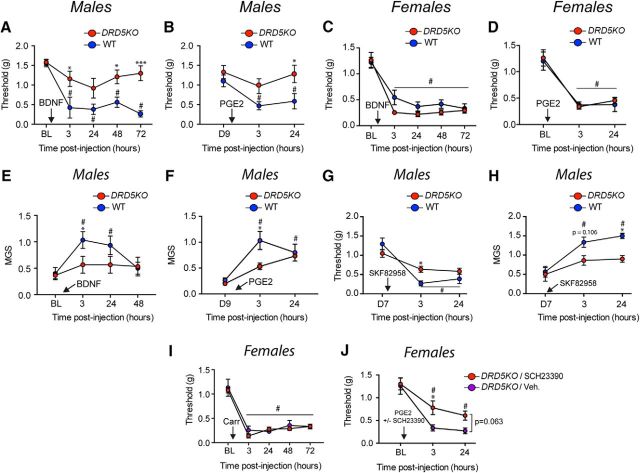Figure 6.
Spinal D5Rs and D1Rs are predominantly involved in the maintenance of hyperalgesic priming in males and females, respectively. A, BDNF fails to produce mechanical hypersensitivity in male DRD5KO mice but produces robust effects in WT mice. N = 6 mice per group. B, Subsequent priming revealed by PGE2 is blocked in male DRD5KO mice at 24 h. N = 6 mice per group. C, In female mice, BDNF produces a robust mechanical hypersensitivity in WT and DRD5KO mice that lasts for at least 72 h. D, Again, injection of PGE2 reveals priming in female DRD5KO and WT mice. N = 5 or 6 mice per group. E, In males, the lack of D5 receptors blocks the development of an affective pain state after an intrathecal injection of BDNF. F, PGE2-induced grimacing in BDNF-primed mice is attenuated in male DRD5KO mice at 3 h after injection. N = 6 mice per group. G, Spinal injection of the D1LR agonist SKF82958 revealed a smaller magnitude of hyperalgesic priming induced by an intraplantar injection of IL-6 in DRD5KO mice, suggesting only a small role for D1Rs in priming in males. N = 6 mice per group. H, Likewise, male DRD5KO mice primed with IL-6 exhibited an attenuation of an affective pain state after spinal injection of the D1RL agonist compared with their WT littermates. N = 5 or 6 mice per group. I, Intraplantar injection of carrageenan 1% produces a strong mechanical hypersensitivity in female DRD5KO and WT mice. J, Intraplantar injection of a D1RL antagonist blocks hyperalgesic priming revealed by PGE2 injection in female DRD5KO mice. N = 6 mice per group. *p < 0.05, WT versus DRD5KO (two-way ANOVA with Bonferroni post hoc test). ***p < 0.001, WT versus DRD5KO (two-way ANOVA with Bonferroni post hoc test). #p < 0.05, compared with baseline (two-way ANOVA with Bonferroni post hoc test).

